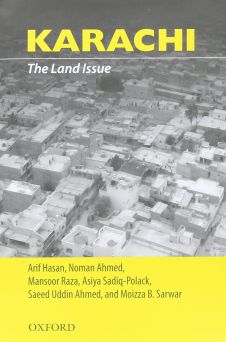Karachi: The Land Issue

Both informal and formal mechanisms govern the ownership and management of the land market in Karachi, Pakistan. This book aims to identify and discuss these mechanisms in a manner that is accessible to practitioners and stakeholders alike. It draws on primary and secondary data, and builds upon research carried out for a working paper entitled “Land ownership, control and contestation in Karachi and implications for low-income housing”, written by Arif Hasan and colleagues in 2013. In the introduction, the authors highlight that despite plentiful laws, statutes and regulations relating to land, their implementation is impeded by Karachi’s method of governance and the lack of a legal framework to coordinate planning and development.
The first of eight chapters provides an introduction to the megacity of Karachi and identifies three key aspects that set it apart from other megacities around the world. These are its location in the regional conflict related to the Afghan war, its economic significance within Pakistan and the Sindh province, and its high migrant population.
Following on, Chapter 2 focuses on the issue of land. It outlines the issues with control and ownership and identifies two key reasons that Karachi fails to meet the needs for commercial growth, low-income housing, amenities and utilities.
Chapter 3 reviews the laws, statutes, and regulations relating to land management in Karachi. Specifically, it looks at the importance of land and how urban land is disposed in Pakistan. The authors discuss relevant laws, review land and urban master plans in Karachi, and provide the views (of both the Provincial Government and the City District Government Karachi) on the Karachi Strategic Development Plan-2020.
Chapter 4 looks at credit for the purchase of land and housing in Karachi by specifically reviewing housing finance. To do this it uses information from interviews with staff at nine formal housing finance institutions and from a review of records and literature on housing finance (page 67). It concludes that in order to address the rising housing deficit in Karachi, finance systems need to cater to lower-income groups and provide them with loans to purchase land where houses can be built incrementally.
In Chapters 5 and 6, Hasan and colleagues discuss the actors and factors in land-related conflicts based upon secondary and primary sources, respectively. The secondary sources in Chapter 5 include five case studies documented by several NGOs in Karachi. From these the authors identify how a political tussle between Karachi’s city and provincial governments allows other forces to exploit the weaknesses in its governance structure (page 77). They also note how a contradiction between supply of land (which is geared towards commercial use) and demand for land (from both commercial enterprises and ordinary citizens) exacerbates the land problem in Karachi.
Chapter 6 relies upon interviews and questionnaire surveys in order to portray: (i) “an account of the builder’s mafia and the role of real estate agents and developers in Karachi” and (ii) “the aspirations and motivations of consumers who live in different types of housing”, including middle-income, lower-income and self-built housing, katchi abadis (squatter settlements), and informal settlements (page 133). These accounts and aspirations reinforce previous conclusions about the increased role of corruption in development.
Chapter 7 turns its attention to non-state stakeholders who support poor communities on land issues in Karachi. Here the authors look at the role of both NGOs and CBOs to improve the physical and social environment of urban poor communities, and how they can influence Karachi’s land market in relation to physical planning, housing credit and networks. Based upon a socioeconomic survey, the authors also discuss issues associated with the affordability and location of housing for residents of low-income settlements.
To conclude, Chapter 8 reviews the factors that drive the current land issues in Karachi. The authors believe that the development of equitable land policies in Karachi is attainable within the scope of existing laws and statutes. However, they assert that rules, regulations and procedures must be simplified to ensure a more equitable application.
Book note prepared by Hannah Keren Lee
Search the Book notes database
Our Book notes database contains details and summaries of all the publications included in Book notes since 1993 - with details on how to obtain/download.
Use the search form above, or visit the Book notes landing page for more options and latest content.
For a searchable database for papers in Environment and Urbanization, go to http://eau.sagepub.com/

